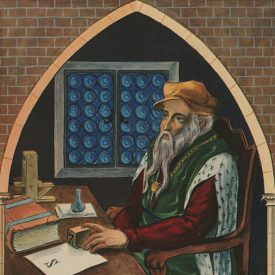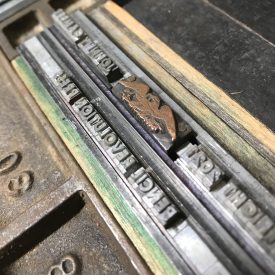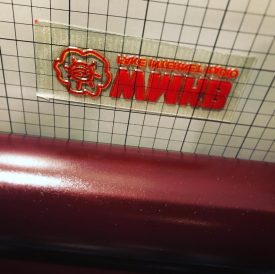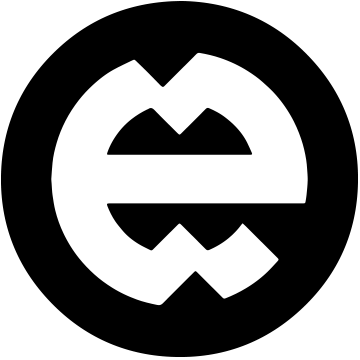What is letterpress printing?
Letterpress printing is a relief printmaking technique that uses type and images carved or etched into wood, metal, and/or polymer. Rollers apply ink to the raised surfaces, then the artwork and paper are pressed together with great force to make a print.

Image courtesy of the Miriam and Ira D. Wallach Division of Art, Prints and Photographs: Print Collection, The New York Public Library.
Letterpress printing has played an important role in world history. Many cultures made relief prints since ancient times, and moveable type was developed in Asia long before letterpress printing as we know it was perfected 500 years ago by Johannes Gutenberg. He and his associates in Mainz, Germany improved the press, developed a practical method to manufacture precise metal type, and concocted new inks, sparking a worldwide explosion of literacy. It’s not overstating the importance of this development to say that it facilitated most cultural and technological advancements that have come since.
After dominating the industry for hundreds of years, letterpress printing was mostly replaced in the mid-20th century by offset printing, which is faster, cheaper, and more precise. Improvements in digital printing are likely to render offset printing largely obsolete by the end of the 2020s. But letterpress printing remains popular thanks to artisan printers who enjoy keeping the history, machinery, and craftsmanship of letterpress alive.
What’s the appeal of letterpress printing?
You’ve read this far, so you hopefully have some nascent attraction to letterpress printing…
Strangely enough, many printers credit Martha Stewart for the current popularity of letterpress printing. In the ’90s, she popularized the idea that the deep impression that letterpress type leaves in the paper is a mark of quality printing. That’s not entirely true… historically, printers and clients might scoff at a visible impression. But it’s true that a visible impression is a distinctive result of letterpress printing, and customers do often seek it out.
We’re happy to eggagerate or minimize the print impression as you wish, but we’d argue the biggest impression that letterpress leaves is the impression made on the viewer.
Letterpress printing imparts soul into print. It takes a good bit of thought, skill, and time to design, typeset, and print your job. Every printed piece was literally touched by the hand of the printer, at every step of the process. It’s special. A little bit magic. There’s a story behind it. The carefully-chosen materials and handcrafted texture, with maybe a hint of imperfection, restore some of the charm that’s lost with modern printing.
What are the limitations of letterpress printing?
We’re not talking about modern technology by any stretch of the imagination. Our shop features a fifty-year-old press, based on a 200-year-old design that wasn’t wildly different than the way they did it in the 1400s. The press is hand-fed: one sheet, one side, one color at a time. It runs on an electric motor, but we do have the original foot-powered treadle (Foot power costs extra).
At 12 one-color impressions per minute, we can’t compete with the blistering 300 six-color sheets per minute of a modern offset press, just as offset’s ho-hum predictability can’t compete with the handmade personality of a piece we print.
There are some design limitations, as well. Full-color reproduction is possible, but there are much easier, cheaper, and more precise ways to do it. Large areas of flat color tend to be a bit mottled (we call it “saltiness”) on some papers. With all the hand-feeding, and printing each color separately, the registration (alignment) of colors is surprisingly precise, but nothing like commercial offset.
But like all craftspeople, we exploit these disadvantages and turn them into advantages. We plan with the process in mind. Limiting (and layering) ink colors, working with available type and illustrations, using unexpected colors, incorporating the paper into the design… it’s an entirely different way of working, and working this way soon makes it clear that computers and 4-color offset printing are equally limiting, in their own ways.
I hear it’s expensive…
Letterpress printing is time-, equipment-, and labor- intensive, and we generally use high-quality paper. So it can be expensive, but it’s actually competitive with offset for certain print jobs. It’s also full of tricks and efficiencies that just aren’t possible with offset printing. So it’s sort of comparing apples to… really special apples that might end up costing about the same. You can find more details about our pricing, and how to mimimize expenses, on our “Working with us” page.
How is the design prepared for printing?

Traditionally, individual characters (or sorts) of cast metal or carved wood type are hand-typeset, letter by letter, word by word, line by line, and locked into a forme with borders and illustrations (“cuts,”). The forme is locked (with quoins and furniture) into a chase (a metal frame) that holds the text in place. The chase is then mounted to the press bed.
Sounds like a lot of work, right? It certainly is, but we still do it just like that! We have dozens of vintage metal and wood fonts and can order custom magnesium or copper ‘cuts’ for logos and artwork.

Thankfully, modern technology allows a simpler and more flexible alternative. We can make polymer plates from digital files. They can be mounted to a block that fits into the press bed. It’s not quite as glamorous, but it’s much easier, and the results look the same.
We can do it either way; hand-set or polymer (or even mix them together, with some limitations), depending on the requirements and budget of the job.
What other processes are related to letterpress printing?
The “impression” that’s possible with letterpress printing is essentially a mild deboss, so yes, we can do that (with or without ink, though we recommend a tint to help it ‘pop.’ Deeper or more complicated debossing and embossing follows the same general principle as letterpress printing, but we have partners who can do it better and more efficiently. The same goes for foil-stamping (a colored or metallic foil is applied with heat and pressure) and die-cutting (punching out a shape)… though we can die cut small jobs in-house. We have vast experience working with friends and vendors (let’s call them friendors!) who do silk-screen printing, offset printing, digital printing, thermography, and any other process you can name. Finishing processes, like folding, trimming, drilling, stitching, and binding are done in-house for small jobs, and sent out for bigger ones.
What else?
Please let us know if you have more questions, as you can see, we can (and do) talk about this stuff all day!

You must be logged in to post a comment.